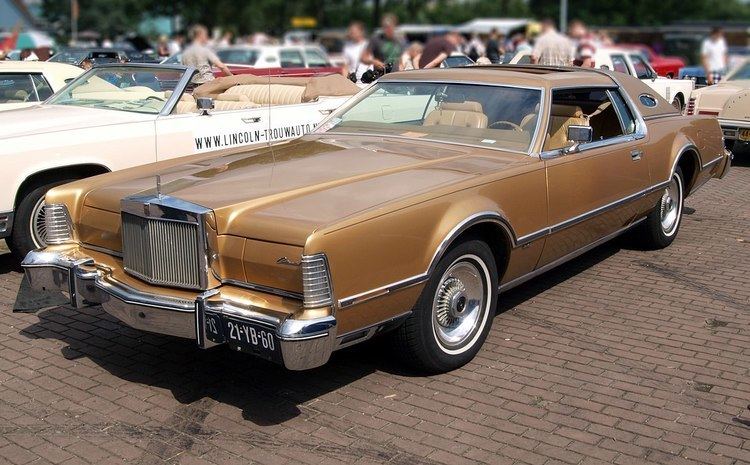Body style 2-door coupe | Production 1972–1976 | |
 | ||
Engine 460 cu in (7.5 L) Ford 385 V8 | ||
The Continental Mark IV is a two-door personal luxury coupe that was sold and marketed by the Lincoln division of Ford Motor Company from the 1972 to 1976 model years. Following the success of the Continental Mark III, Lincoln renewed the model line to again compete against the Cadillac Eldorado.
Contents
Sharing the underpinnings and much of the roofline with the redesigned Ford Thunderbird for 1972, the Mark IV was given distinct body styling from the windows down. In addition, the Mark was distinguished by hidden headlights and the "Continental spare tire" trunklid.
All Continental Mark IVs were assembled at the Wixom Assembly Plant in Wixom, Michigan, alongside the standard Lincoln Continental and the Ford Thunderbird. For 1977, the Mark IV underwent a substantial exterior styling revision and was replaced by the Continental Mark V.
Design
Following the successful redesign of the Lincoln Continental for the 1970 model year, Ford Motor Company chose an evolutionary design path for the successor of the Continental Mark III. With designers again using sharp-edged fenders, hidden headlamps, and a tall radiator-style grille, the Continental Mark IV retained the traditional "long-hood, short deck" coupe proportions of the Mark III along with its "Continental spare tire" decklid.
In a cost cutting move, however, Ford Motor Company forced the Mark IV to increase parts commonailty with the Ford Thunderbird; while the roofline, doors, and inner body panels were shared, the Mark IV and Thunderbird still were given different outer body panels below the roofline and different interiors. In a major break from American luxury car tradition, the rear wheel openings of the Mark IV were designed at the same height as the front wheels (similar to the 1966-1970 Oldsmobile Toronado); its large fender flares precluded the use of fender skirts.
In 1973, the front bodywork underwent a major redesign, necessitated by the addition of 5 mph bumpers; in various forms, the front body style would be seen on Continentals and Lincolns until 1989. For 1974, a 5 mph bumper was added to the rear body work, moving the taillights from the bumper into the rear bodywork.
All Mark IVs were equipped with a vinyl roof. The Mark IV introduced the opera window to the Mark series, a feature that would be featured in the Mark through the discontinuation of the Mark VI after 1983. For 1972, it was an almost universally specified option, becoming standard for 1973.
Mechanical specification
All Mark IVs were equipped with the 460 cu in (7.5 L) Ford 385 series V8 engine. All 1972 Mark IVs were rated at 365 bhp gross, the engine being a direct carry-over from the previous Mark III. In 1973 compression-ratio was lowered considerably due to new changing EPA requirements, and Ford adopted a new SAE method of measuring horsepower, resulting in 212 SAE net hp (158 kW). The performance-gap between the 1972 and its later-year brethren was significant. All model years drove through a C6 three-speed automatic transmission.
A feature retained from the Mark III was "Sure-track" brakes, making the Mark IV one of the first American cars to become equipped with anti-lock brakes. Both front seats were power adjustable.
Performance was not competitive with contemporary premium personal luxury cars. However, no other "personal luxury" models were six-passenger vehicles, except the Cadillac Eldorado.
Continental Mark IV designer editions
The Mark IV debuted a new tradition for the Mark series, which later spread to other models in the Lincoln model range. Earlier, the Mark III had an Cartier-branded clock installed optionally. In 1976, the Designer Series was introduced as four special-edition models. Each edition was an option package with color, trim, and interior choices specified by notable fashion designers (Bill Blass, Cartier, Givenchy, and Pucci). Each edition carried the designer's signature on the opera windows and were fitted with a 22 karat (92%) gold-plated plaque on the instrument panel which could be engraved with the original owner's name. The concept was successful and would continue on other Lincolns until the end of the 2003 model year.
For 1976, four designer editions were offered:
